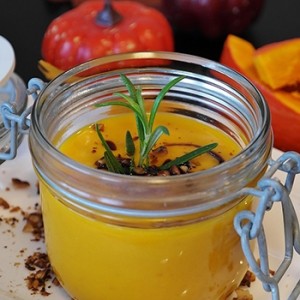Nutrition blog
Recipes – interesting facts – tips – inspiration, whether:
Diet, vegan, vegetarian, paleo or just health-conscious…
Recipes – interesting facts – tips – inspiration, whether:
Diet, vegan, vegetarian, paleo or just health-conscious…
Stalls selling fresh pumpkins have been set up in the fields again for a few weeks now. There are now many different types, which can be prepared differently for tasting depending on the variety.
I would therefore like to give you a brief overview of the best-known pumpkin varieties.
Curcubita, as the pumpkin genus is also known, is an annual plant that originally comes from America. It has now established itself worldwide as a tasty vegetable and a wide range of varieties have also been successfully cultivated in Germany for years.
One of the best-known pumpkin varieties is the “Hokkaido“. Although it belongs to the genus of giant pumpkins, its size is limited. As its skin is very thin, this pumpkin is ideal for a wide variety of preparations: Cut into pieces and sautéed in a pan, it can also be made into chutney. It is also suitable for preparing a tasty pumpkin soup, which can even be served in the pumpkin itself. The Hokkaido is a true all-rounder among edible pumpkins. It also usually contains nice large pumpkin seeds, which can be roasted and enjoyed as a snack side dish.
This giant pumpkin is best known as a carved “Halloween pumpkin”. The giant centner has rightly earned its name, as one specimen can weigh over 50 kg. Its yellow flesh tastes quite mild and is therefore ideal for pickling, as a soup or as pumpkin chutney.
The colors of the nutmeg pumpkin can vary from light/dark green to juicy orange to a light beige. The nutmeg pumpkin belongs to the genus of musk pumpkins and owes its name to its nutmeg-like aroma. Its flesh tastes slightly spicy and is ideal for a tasty pumpkin puree, as a soup or can also be used for desserts. Another advantage of the nutmeg pumpkin: it is low in calories and fat and can therefore be enjoyed without hesitation.
 Another now well-known and popular pumpkin is the butternut. It also belongs to the musk pumpkin family and has a tasty, nutty aroma. Compared to the proportion of flesh, the pear pumpkin, as the butternut is often called due to its shape, has relatively few seeds. It can be cut into very thin slices and eaten raw in a salad, for example, while slightly thicker slices are ideal for a “pumpkin cutlet” in a pan or on the grill. Butternut can also be used to make a tasty puree or pumpkin soup.
Another now well-known and popular pumpkin is the butternut. It also belongs to the musk pumpkin family and has a tasty, nutty aroma. Compared to the proportion of flesh, the pear pumpkin, as the butternut is often called due to its shape, has relatively few seeds. It can be cut into very thin slices and eaten raw in a salad, for example, while slightly thicker slices are ideal for a “pumpkin cutlet” in a pan or on the grill. Butternut can also be used to make a tasty puree or pumpkin soup.
Not everyone is familiar with the spaghetti squash as a garden pumpkin, but once you’ve cooked it yourself, you’ll become a huge fan. This type of pumpkin is cooked whole and then cut in half. First remove the seeds with a fork and then carefully scrape out the flesh. This forms elongated, spaghetti-like strings that can even be rolled up with a fork – hence its name: spaghetti squash. A low-calorie alternative to the actual pasta dish and with a fine sauce it becomes a delicious “pumpkin pasta”.
And who would have thought it? The zucchini is a subspecies of the garden pumpkin and thus belongs to the pumpkin family. The great thing about zucchinis is that they can be grown in the garden or are available in grocery stores all year round. Zucchinis can be prepared in many different ways: from raw to roasted, grilled, stuffed or even as zucchini spaghetti – there are no limits to creativity with zucchinis.
There is a large selection of tasty pumpkins and a wide range of preparation options. Pumpkin not only tastes great, it also contains healthy ingredients such as vitamins from groups A, C, D and E, zinc, calcium and potassium. The silica in the pulp is good for hair, nails and skin.
The species listed here can be stored in cool places for several weeks to months. You can also freeze pieces of pumpkin or the finished soup and prepare it for future meals.
You can find a recipe for vegan pumpkin soup here:
Enjoy a golden fall and pumpkin season.
If you choose me as your nutritionist, you will receive individual advice and support tailored to you and your goals, wishes and needs.
I will meet you where you currently are and guide you towards your new, healthier, happier lifestyle.
Silke Schweitzer – Ernährungsberaterin
+34-657-477 633
+49-170-4857458
info@e-schweitzer.de
Marbella
29010 Málaga

 OMEGA-3 fatty acids
OMEGA-3 fatty acids